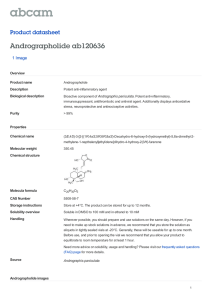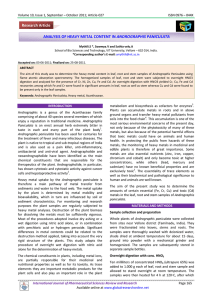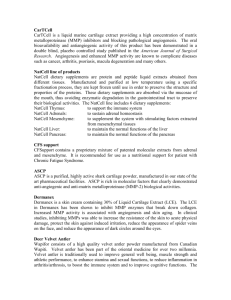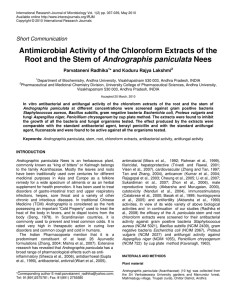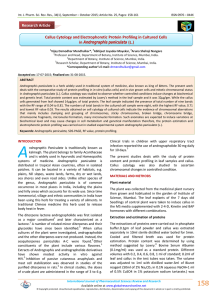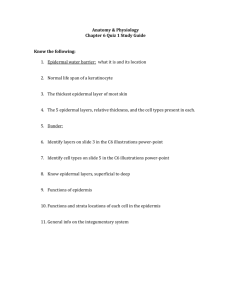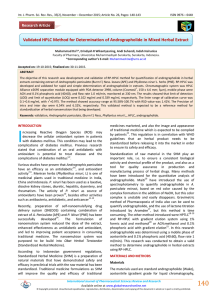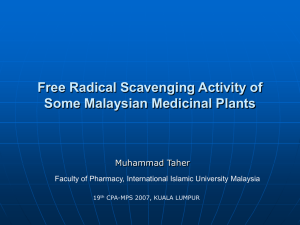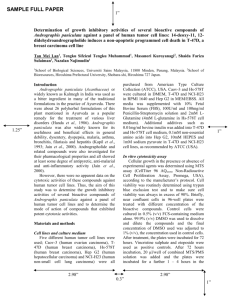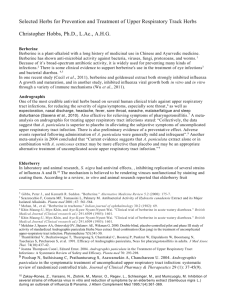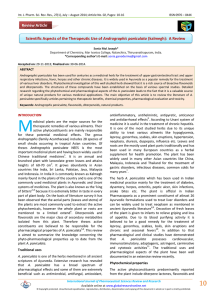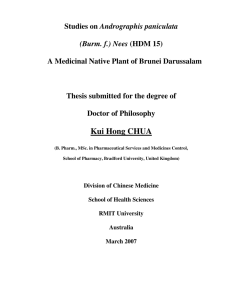Document 13309707
advertisement
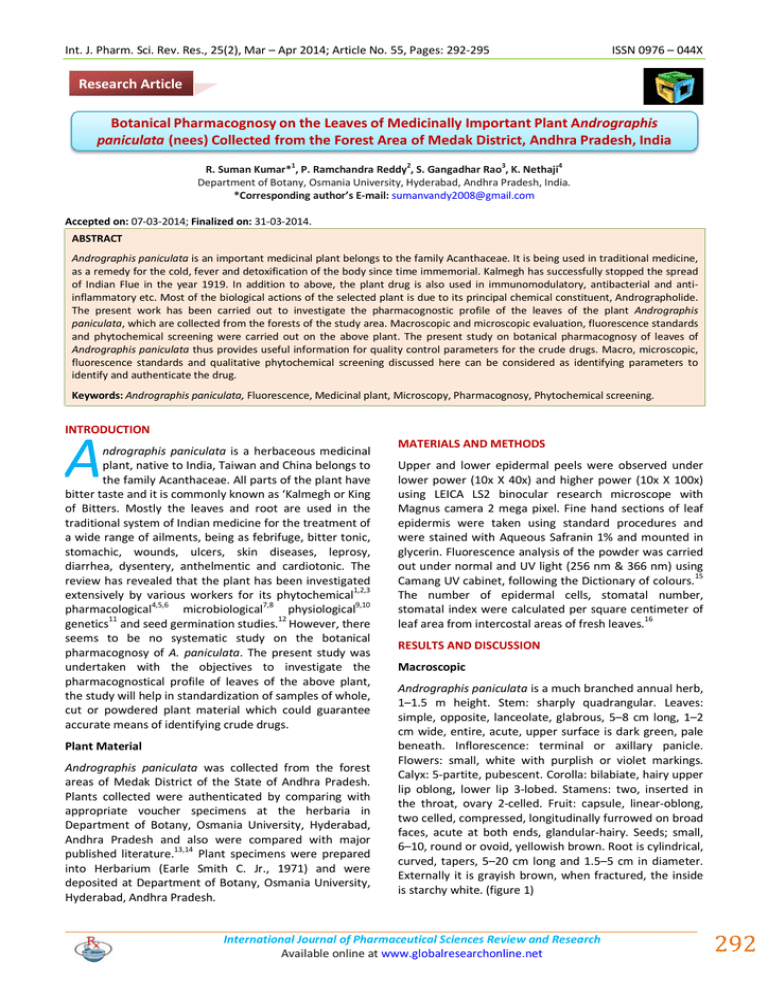
Int. J. Pharm. Sci. Rev. Res., 25(2), Mar – Apr 2014; Article No. 55, Pages: 292-295 ISSN 0976 – 044X Research Article Botanical Pharmacognosy on the Leaves of Medicinally Important Plant Andrographis paniculata (nees) Collected from the Forest Area of Medak District, Andhra Pradesh, India 1 2 3 4 R. Suman Kumar* , P. Ramchandra Reddy , S. Gangadhar Rao , K. Nethaji Department of Botany, Osmania University, Hyderabad, Andhra Pradesh, India. *Corresponding author’s E-mail: sumanvandy2008@gmail.com Accepted on: 07-03-2014; Finalized on: 31-03-2014. ABSTRACT Andrographis paniculata is an important medicinal plant belongs to the family Acanthaceae. It is being used in traditional medicine, as a remedy for the cold, fever and detoxification of the body since time immemorial. Kalmegh has successfully stopped the spread of Indian Flue in the year 1919. In addition to above, the plant drug is also used in immunomodulatory, antibacterial and antiinflammatory etc. Most of the biological actions of the selected plant is due to its principal chemical constituent, Andrographolide. The present work has been carried out to investigate the pharmacognostic profile of the leaves of the plant Andrographis paniculata, which are collected from the forests of the study area. Macroscopic and microscopic evaluation, fluorescence standards and phytochemical screening were carried out on the above plant. The present study on botanical pharmacognosy of leaves of Andrographis paniculata thus provides useful information for quality control parameters for the crude drugs. Macro, microscopic, fluorescence standards and qualitative phytochemical screening discussed here can be considered as identifying parameters to identify and authenticate the drug. Keywords: Andrographis paniculata, Fluorescence, Medicinal plant, Microscopy, Pharmacognosy, Phytochemical screening. INTRODUCTION A ndrographis paniculata is a herbaceous medicinal plant, native to India, Taiwan and China belongs to the family Acanthaceae. All parts of the plant have bitter taste and it is commonly known as ‘Kalmegh or King of Bitters. Mostly the leaves and root are used in the traditional system of Indian medicine for the treatment of a wide range of ailments, being as febrifuge, bitter tonic, stomachic, wounds, ulcers, skin diseases, leprosy, diarrhea, dysentery, anthelmentic and cardiotonic. The review has revealed that the plant has been investigated extensively by various workers for its phytochemical1,2,3 4,5,6 7,8 9,10 pharmacological microbiological physiological 11 12 genetics and seed germination studies. However, there seems to be no systematic study on the botanical pharmacognosy of A. paniculata. The present study was undertaken with the objectives to investigate the pharmacognostical profile of leaves of the above plant, the study will help in standardization of samples of whole, cut or powdered plant material which could guarantee accurate means of identifying crude drugs. Plant Material Andrographis paniculata was collected from the forest areas of Medak District of the State of Andhra Pradesh. Plants collected were authenticated by comparing with appropriate voucher specimens at the herbaria in Department of Botany, Osmania University, Hyderabad, Andhra Pradesh and also were compared with major published literature.13,14 Plant specimens were prepared into Herbarium (Earle Smith C. Jr., 1971) and were deposited at Department of Botany, Osmania University, Hyderabad, Andhra Pradesh. MATERIALS AND METHODS Upper and lower epidermal peels were observed under lower power (10x X 40x) and higher power (10x X 100x) using LEICA LS2 binocular research microscope with Magnus camera 2 mega pixel. Fine hand sections of leaf epidermis were taken using standard procedures and were stained with Aqueous Safranin 1% and mounted in glycerin. Fluorescence analysis of the powder was carried out under normal and UV light (256 nm & 366 nm) using Camang UV cabinet, following the Dictionary of colours.15 The number of epidermal cells, stomatal number, stomatal index were calculated per square centimeter of 16 leaf area from intercostal areas of fresh leaves. RESULTS AND DISCUSSION Macroscopic Andrographis paniculata is a much branched annual herb, 1–1.5 m height. Stem: sharply quadrangular. Leaves: simple, opposite, lanceolate, glabrous, 5–8 cm long, 1–2 cm wide, entire, acute, upper surface is dark green, pale beneath. Inflorescence: terminal or axillary panicle. Flowers: small, white with purplish or violet markings. Calyx: 5-partite, pubescent. Corolla: bilabiate, hairy upper lip oblong, lower lip 3-lobed. Stamens: two, inserted in the throat, ovary 2-celled. Fruit: capsule, linear-oblong, two celled, compressed, longitudinally furrowed on broad faces, acute at both ends, glandular-hairy. Seeds; small, 6–10, round or ovoid, yellowish brown. Root is cylindrical, curved, tapers, 5–20 cm long and 1.5–5 cm in diameter. Externally it is grayish brown, when fractured, the inside is starchy white. (figure 1) International Journal of Pharmaceutical Sciences Review and Research Available online at www.globalresearchonline.net 292 Int. J. Pharm. Sci. Rev. Res., 25(2), Mar – Apr 2014; Article No. 55, Pages: 292-295 ISSN 0976 – 044X powders are soaked in water and methanol were observed to establish authentification of the plant powders for their colours. The colours exhibited by the extract and the residue of leaf powders were clearly explained in table-1, figure 5. Figure 1: Andrographis paniculata -Habit Microscopic Evaluation of Leaves Upper epidermis The upper surface is dark green and surface is smooth without epidermal trichomes, cells are 5-7 sided and mostly polygonal anisodiametric cells. The anticlinal cell walls are curved to wavy, thin walled, outer wall is flat with epidermal cells, surface is minute pointed epidermal out growths are present. The epidermal cells are size wise varied within the same surface as the bigger size of epidermal cells present on either side of midvein. The epidermal cells are smaller on the apex region, base and on margin. Cytoplasm is scanty and the distribution of epidermal cells are irregularly arranged and variously distributed. Costal cells are rectangular or barrel shaped isodiametric rarely aniosdiametric with outer surface convex, anticlinal walls are straight, thin walled, cytoplasm is scanty, cells are arranged parallel to the leaf axis along with midvein and variously oriented. Crystals are maximum on costal cells and also bigger size crystals are more. Crystals are druces and are carrot shaped small and big size. The crystals are grape to round shape arranged in the form of Ashoka tree shape. The distribution is they are irregularly arranged and arranged in horizontal to the midvein. Epidermal cells distributed 0 0 throughout except on primary 1 , 2 veins. Trichomes are absent on upper epidermis. The average lower epidermal cell count was 137 cells per 400x. Stomata are absent on upper epidermis, hence the plant leaves are hypostomatic. (figures 2,3) Figure 2: Showing the upper epidermal cells Figure 3: Showing the cystoliths in upper epidermal cells Figure 4: Showing the lower epidermal cells Lower Epidermis The lower surface is pale green and without any trichomes, cells are polygonal anisodiametric and rarely isodiametric, 5-7 sided. Anticlinal cell walls are sinuated with U and V curvature. The cell walls are thin, cytoplasm scanty, outer wall is flat. Costal cells are only on mid veins. Crystals mostly are small sized, trichomes absent. The average lower epidermal cell count was 107 cells per 400x. Stomata are mostly diacytic types, stomatal frequency is 43 cells per 400x and the stomatal index observed is 28 cells per 400x. (figure 4) Figure 5: Colour characterisation of leaf powders Phytochemical screening Preparation of extracts Fluorescence standards Fresh leaves of Andrographis paniculata growing wild in the forests of Medak District were used for their colour characterisation under normal and UV light. The leaf To prepare the methanolic extract, 150 g of each of the ten plant material was collected, dried in the oven at 700C for 4 h and reduced to powder. It was separately International Journal of Pharmaceutical Sciences Review and Research Available online at www.globalresearchonline.net 293 Int. J. Pharm. Sci. Rev. Res., 25(2), Mar – Apr 2014; Article No. 55, Pages: 292-295 macerated with the above solvent and allowed to stand for 72 hrs and then filtered. The filtrates were then evaporated under reduced pressure and dried using a rotary evaporator at 55°C. Dried extracts were stored in labeled sterile screw capped bottles at 5°C in the refrigerator, until when required for use. For the aqueous extraction, 50 g of the plant powder was weighed into 50 ml Eylen-Mayer flask and to this was added 400 ml of distilled water. This was heated to boil using hot plate. The mixture was stirred at regular intervals (3-5 min) for one hour after which it was filtered with No. 1 Whatman filter paper (W and R Balson Ltd, England). The filtrate was then filtered sterilized using a membrane filter of pore size 0.45 cm diameter (millipores corp, England). The ISSN 0976 – 044X o extracts were concentrated in a hot water bath at 80 C for 5 h during which 0.5 g charcoal was added to decolorize it. Sterile decolorized filtered extract was then 0 refrigerated at 5 C until required for use. Phytochemical analysis Standardization of plant extract (Juice) was done with the help of extractive values (water and methanolic).17 Chemical tests for the screening and identification of bioactive chemical constituents in the medicinal plants under study were carried out in extracts as well as powder specimens using the standard procedures as described by; 18-21 Table 1: Fluorescence standards of leaf powder extract and residue under O.L and U.V light Under normal light Under uv light Dist. Water Methanol Dist. Water Methanol Name of the colour Name of the colour Name of the colour Name of the colour Sup. Res Sup. Res Sup. Res Sup. Res Corinthian Pk. Gargoyle Piquant Gr. Cerro Gr. Asphodel Gr. Cypress Gr+ Pyrite Y. Fluorite Gr. Table 2: Showing the phytochemical screening of leaf powders in water and methanol Phytochemical Constituents Dist. Water Methanol Flavonoids + + Alkaloids + +++ Glycosides + - Steroids Trace ++ Phenols + ++ Terpenoids + Trace Saponins + Trace resins, carboxylic completely absent. acids and xanthoproteins are Resins + + Tannins + +++ Cardiac Glycosides + ++ CONCLUSION Carboxylic acid - ++ Coumarins + ++ Quionones + ++ Xanthopretins + ++ The present study on botanical pharmacognosy of Andrographis paniculata provides useful information for quality control parameters for the crude drugs. Macro, microscopic, powder, fluorescence standards discussed here can be considered as identifying parameters to substantiate and authenticate the drug and leaves a scope for further investigations. The results of the phytochemical analysis of the leaf extracts in aqueous and methanolic extractions have shown a notable variation of phytochemical compounds. The detailed screening of fourteen phytochemicals are shown in table 2, figure 6. The study revealed that the leaf extracts of Andrographis paniculata are showing the presence of alkaloids, glycosides, phenols, terpenoids, saponins, tannins, cardiac glycosides, coumarins, quinines, xanthoproteins but flavonoids, steroids, resins and carboxylic acid are absent. While in methanolic extracts, flavonoids, alkaloids, glycosides, steroids, phenols, terpenoids, saponins, tannins, cardiac glycosides, coumarins, quinines shown their presence, whereas Figure 6: Phytochemical screening of leaf powders Acknowledgment: The author is very much thankful to the Co-ordinator, UGC-CPEPA programme, Department of Biochemistry and the Department of Botany, university college of Science, Osmania university for their continuous financial help and laboratory support in completion of this paper. REFERENCES 1. Sharma A, Lal K, Handa SS, Standardisation of the Indian crude drug Kalmegh by high-pressure liquid chromatographic determination of andrographolide, Phytochem Anal., 3, 1992, 129–31. International Journal of Pharmaceutical Sciences Review and Research Available online at www.globalresearchonline.net 294 Int. J. Pharm. Sci. Rev. Res., 25(2), Mar – Apr 2014; Article No. 55, Pages: 292-295 ISSN 0976 – 044X 2. Kleipool R, Constituents of Andrographis paniculata Nees, Nature, 169, 1952, 33–34. 3. Li W, Xu X, Zhang H, Secondary metabolites from Andrographis paniculata, Chem Pharm Bull (Tokyo), 55, 2007, 455–458. 12. Saraswathy S, Manavalan RSA, Vadivel E, Manian K, Study on seed germination in Kalmegh (Andrographis paniculata Nees), South Ind Horticul., 52(1–6), 2004, 286–290. 4. Rana AC, Avadhoot Y, Hepatoprotective effects of Andrographis paniculata against carbon tetrachloride induced liver damage, Arch Pharmac Res., 14, 1999, 93–95. 13. Chopra RN, Nayar SL, Chopra IC, Glossary of Indian Medicinal Plants, Council of Scientific and Industrial Research, New Delhi, CSIR, New Delhi, 1956. 5. Madav S, Tripathi HC, Mishra SK, Analgesic, antipyretic and anti-ulcerogenic effects of andrographolide, Ind J Pharm Sci., 57, 1995, 121–125. 14. Sharma PP, Singh NP, Ethnobotany of Dadra Nagar Haveli and Daman, (Union Territories), Botanical Survey of India, Kolkata, 2001. 6. Shen YC, Chen CF, Chiou WF, Andrographolide prevents oxygen radical production by human neutrophils: possible mechanism(s) involved in its anti-inflammatory effect, Br J Pharmacol., 135(2), 2002, 399–406. 15. Mearz and Paul, Dictionary of Colours, Mc Graw Hill book nd company, INC, New York, 2 edition, 1950. 16. Salisbury EJ, On the causes and ecological significance of stomatal frequency with special reference to the woodland flora, Philos Trans R Soc London, B 216, 192, 1–65. 17. Phytochemical and Pharmacological screening of wheatgrass juice (triticum aestivum l.), International Journal of Pharmaceutical Sciences Review and Research, 9 (1), 2011, 159-164. 18. Sofowora A, Medicinal Plants and Traditional Medicine in Africa, John Wiley and Sons Limited, 2, 1993, 96-106. 19. Trease GE, Evans WC, Pharmacognos,. Saunders, 15 Edn, 2002, 214-393. 20. Harborne JB, Methods of plant analysis, Phytochemical Methods, Chapman and Hall, London, 1973. 21. Parekh J, Chand S, Phytochemical screening of some plants from Western regions of India, Plant Arch., 8, 2008, 657662. 7. 8. Singha PK, Roy S, Dey S, Antimicrobial activity of Andrographis paniculata, Fitoterapia, 74(7–8), 2003, 692– 694. Gupta S, Choudhry MA, Yadava JNS, Srivastava V, Tandon JS, Anti-diarrhoeal activity of diterpenes of Andrographis paniculata (Kalmegh) against Escherichia coli enterotoxin in- vivo models, Int J Crude Drug Res., 28, 1990, 273–283. 9. Zhao HY, Fang WY, Antithrombotic effects of Andrographis paniculata Nees in preventing myocardial infarction, Chinese Med J (Engl), 104, 1991, 770–775. 10. Zhang Z, Jiang J, Yu P, Zeng X, Larrick JW, Wang Y, Hypoglycemic and beta cell protective effects of andrographolide analogue for diabetes treatment, J Translational Med., 7, 2009, 62–73. 11. Padmesh P, Sabu KK, Seeni S, Pushpangadan P, The use of RAPD in assessing genetic variability in Andrographis paniculata Nees, a hepatoprotective drug, Curr Sci., 76, 199, 833–835. th Source of Support: Nil, Conflict of Interest: None. Corresponding Author’s Biography: R.Suman Kumar Mr. R.Suman Kumar graduated and professionalised at Osmania University, India. In Post graduation taken Plant physiology and molecular biology as specialisation and submitted thesis on “Ethnobotanical and Pharmacognostic studies of plants used by Gondu tribes at Seethagondi GP, Adilabad Dist. Andhra Pradesh, India” for his Doctoral degree. Currently working as Project Associate in UGC-CPEPA programme at Department of Botany, Osmania University, India. International Journal of Pharmaceutical Sciences Review and Research Available online at www.globalresearchonline.net 295
